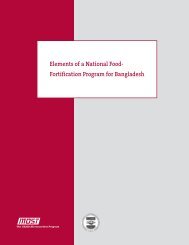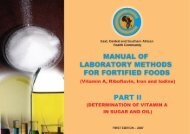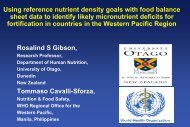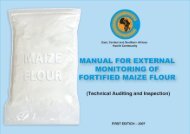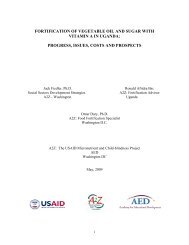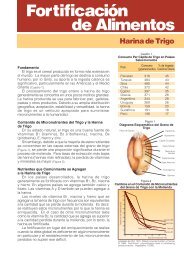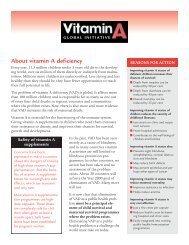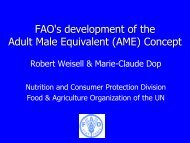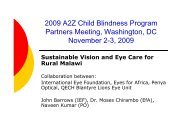manual of methods for determining micronutrients in fortified foods
manual of methods for determining micronutrients in fortified foods
manual of methods for determining micronutrients in fortified foods
You also want an ePaper? Increase the reach of your titles
YUMPU automatically turns print PDFs into web optimized ePapers that Google loves.
Note: Prior to start analyz<strong>in</strong>g samples, determ<strong>in</strong>e the optimum growth time and calibrate the<br />
spectrophotometer follow<strong>in</strong>g the steps described <strong>in</strong> Steps X and XI.<br />
E. Sample preparation<br />
1. Gr<strong>in</strong>d solid samples and homogenize them.<br />
2. In a 250-mL Erlenmeyer flask, weigh 2 g wheat flour.<br />
3. Add 50 mL distilled water treated with activated carbon and mix well.<br />
4. Add 5 mL amylase-10% to the cereal based samples or 1 mL pancreat<strong>in</strong>e-4% to the dairy samples.<br />
Cover with a 50-mL beaker or with alum<strong>in</strong>um paper and <strong>in</strong>cubate at 37°C overnight.<br />
5. Sterilize the solution <strong>in</strong> an autoclave at 121-123°C <strong>for</strong> 15 m<strong>in</strong>utes.<br />
6. Mix well and cool the flasks down <strong>in</strong> a water bath with ice until they reach room temperature.<br />
7. Transfer to a 200 mL volumetric flask and br<strong>in</strong>g to volume with distilled water treated with activated<br />
charcoal and agitate the solution.<br />
8. Centrifuge 25 mLsolution at 3,000 rpm <strong>for</strong> 5 m<strong>in</strong>utes.<br />
9. Take 5 mL supernatant and transfer to a 100 mL volumetric flask with distilled water treated with<br />
activated charcoal and agitate.<br />
10. If the solution is turbid, filter through filter paper Whatman No. 5 and if turbidity persists, filter<br />
through a 0.45 µm membrane.<br />
F. Microbiological assay<br />
1. Prepare the follow<strong>in</strong>g tubes with screw cap:<br />
• 3 empty tubes <strong>for</strong> un<strong>in</strong>oculated blanks which will be used as sterilization controls.<br />
• 3 empty tubes <strong>for</strong> <strong>in</strong>oculated blanks. Controls to check chemical contam<strong>in</strong>ation <strong>of</strong> reagents, media<br />
and water used <strong>in</strong> the analysis, as well as the <strong>in</strong>oculum purity.<br />
• 10 tubes conta<strong>in</strong><strong>in</strong>g 0.5, 1, 2, 3, 4 and 5 mL folic acid work<strong>in</strong>g standard solution-1 ng/mL, respectively.<br />
Prepare each volume <strong>in</strong> duplicate.<br />
• Per sample: 10 tubes conta<strong>in</strong><strong>in</strong>g 0.5, 1, 2, 3 and 4 mL sample f<strong>in</strong>al extract, <strong>in</strong> duplicate.<br />
2. Add distilled water treated with activated charcoal to the tubes to get a f<strong>in</strong>al volume <strong>of</strong> 5 mL, as<br />
<strong>in</strong>dicated <strong>in</strong> the follow<strong>in</strong>g table:<br />
- 57 -





